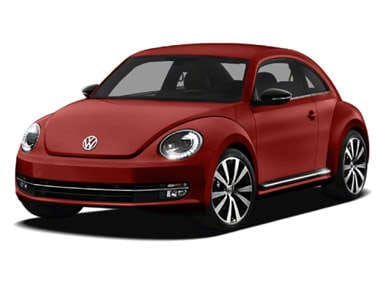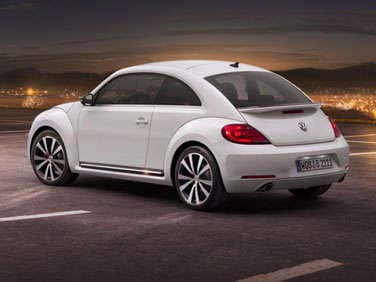Recent Articles
Popular Makes
Body Types
2012 Volkswagen Beetle: Road Test and Review

With the emergence of a newly revised Beetle has come the inevitable criticism of the 1998 – 2011 Volkswagen New Beetle. It’s a remarkable phenomenon. When a car as iconic as the New Beetle was introduced in 1998, the praise was heaped on almost infinitely.
Then, when its succeeding model sees the light of day, in this case, the third-generation Beetle (“New” has been dropped from the name) has broken cover, reviewers, rushing to heap praise upon the third-generation car are decrying the second-generation car as too effeminate, too “round” and not true enough conceptually to the original (Type 1) car.
It’s human nature I guess, but frankly, people should go back and read their original fawning reviews before trashing the predecessor in their effort to deify the successor.
2012 Volkswagen Beetle: Pricing and Trim Levels
Pricing for the 2012 Beetle starts at $18,995 for the base 2.5L Beetle. The next rung up the pricing ladder is the $22,295 2.5L Beetle w/Sunroof. A 2.5L Beetle w/Sunroof, Sound and Navigation starts at $24,095.
The base Turbo Beetle actually starts lower than the 2.5L Beetle w/Sunroof, Sound and Navigation at $23,395—but that’s because the sunroof, sound and navigation systems are pre-packaged for the Beetle Turbo too.
Fold those into the mix and you’ll be looking at either $26,395 for Beetle Turbo w/ Sunroof and Sound, or $27,995 for a 2012 Volkswagen Beetle Turbo w/Sunroof, Sound and Navigation. Add in the automatic transmission, and the top starting MSRP for the 2012 Beetle is $29,095.

2012 Volkswagen Beetle: Competition
When it comes to direct competitors it can safely be said the 2012 Volkswagen Beetle doesn’t really have any. Anybody wanting a Beetle probably doesn’t want anything else—because nothing else is really like it. However, if you had to pigeonhole the car, it falls into the “cute-car” category with the MINI Cooper, FIAT 500 and to a lesser extent, the Scion iQ. However, the Beetle is larger than all of those cars, not really as sporty as the Mini and plays in a completely different league than the Fiat and the Scion.

2012 Volkswagen Beetle: Exterior
Proportionally, the 2012 Volkswagen Beetle is, in fact, closer to the lines of the original car than the 1998 New Beetle was. Where three semi-circles characterized that design, this new design relies more upon semi-ovals. The roof is flatter, the nose is longer, the windshield is more upright and the overall proportions of the car are larger and more muscular than the New Beetle it replaces.
About the design, Volkswagen brand design chief Klaus Bischoff says;
“The Beetle is now characterized by a clean, self-confident and dominant sportiness. The car not only has a lower profile; it is also substantially wider, the front hood is longer, the front windshield is shifted farther back and has a much steeper incline. All of this creates a new dynamism.”
If, by a “new dynamism” he means the car looks more “butch” than “girly” he’s absolutely correct.
For those of you enamored with numbers:
The 2012 Beetle is 71.2 inches wide (3.3 inches wider), 58.5 inches tall (0.5 inches lower) and 168.4 inches long (6.0 inches longer). The fact the car looks more aggressive is not up for debate. It absolutely does, particularly when configured in Turbo livery with the optional 19-inch wheel and the integrated tail spoiler. The standard wheel for the Turbo is 18-inches, the base 2.5L car gets a 17-inch tire mounting device.

2012 Volkswagen Beetle: Interior
Behind the steering wheel the Beetle pilot faces three round gauges containing the tachometer, speedometer, and fuel gauge. Housed within the centrally mounted speedometer, is a multifunction display offering (depending upon how your Beetle is equipped), trip, entertainment system, and/or navigation system readouts.
If you get a Beetle Turbo w/ Sunroof, Sound & Navigation, your seats will be upholstered in leather; any other Turbo leaves you perched on cloth. If you go 2.5L you’ll sit either on cloth, or Volkswagen’s “Leatherette” vinyl—if you get Sunroof & Sound, or Sunroof Sound & Navigation. A high-grade material, most occupants will assume it’s leather, unless they’re told otherwise.
The dash, upper door panels and even the steering wheel bring the exterior color of the Beetle inside the car and the Turbo adds a pod of three gauges to the top of the dash for monitoring oil, water and the electrical system. Another Turbo touch is brushed aluminum pedals with rubber inserts.
Regardless of the Beetle model you choose, you’ll get power windows, Bluetooth hands-free calling for your phone and an iPod interface. As you move up in the trim levels, you’ll add things like a leather wrapped multifunction steering wheel, keyless access with push-button start, and the aforementioned multifunction trip computer.
The “sound” portion of the Sunroof, Sound & Navigation package comes courtesy of Fender audio. While the company is probably best known for its line of electric guitars and amplifiers, turns out it makes a darn good car audio system too.

2012 Volkswagen Beetle: Packages and Options
Volkswagen’s product planners made a concerted effort to make ordering a 2012 Beetle as simple as possible. Thus, there really isn’t a plethora of options and packages. The cars come pretty much preconfigured. Basically, all you have to decide is which engine you want, which transmission, what color, and whether you want a sunroof, an upgraded sound system, and/or a navigation system.
Of course, this means in order to get the upgraded sound system, you also have to get the sunroof, and to get the navigation system, you also have to get the sunroof and the upgraded audio system.
But hey, when all’s said and done, you’ll have a really nicely configured Beetle if you go for it all.
Oh, y the way, if you opt for one of the automatic transmissions over one of the manual ones, you’ll add $1100 to the prices quoted in the Pricing & Trim section of this article. The only other choice you have to make affecting pricing is the $1000, bi-xenon headlights/19-inch wheel-set bundle for the Beetle Turbo.
Thus, a fully-loaded 2012 Volkswagen Beetle Turbo w/Sunroof, Sound, Navigation, a six-speed automatic transmission, 19-inch wheels, and bi-xenon headlights (pause here to catch your breath) comes in at $29,865—after the $770 destination charges are included. A base Beetle 2.5L with a five-speed manual transmission comes in at $20,565, with destination charges.

2012 Volkswagen Beetle: Powertrains and Fuel Economy
OK, now this is the part where we explain the 2.5L and Turbo designations.
Basically, any Beetle dubbed (no pun intended—as in Vee-Dub) 2.5L, houses Volkswagen’s 170-horsepower 2.5-liter inline five-cylinder engine producing 177 ft-lbs of torque. Volkswagen pairs its six-speed automatic transmission with this engine as an extra-cost option. A five-speed manual transmission is the standard offering. Fuel economy is quoted at 20-city/29-hwy with the automatic and 20/28 with the manual.
Any Beetle with Turbo written across its butt (assuming it came that way from the factory), is rocking a 200-horsepower, 2.0-liter inline four-cylinder engine, generating 207 ft-lbs of torque. Transmission choices here are six-speed manual and six-speed direct shift gearbox (DSG) semi-automatic. With the six-speed manual VW says you can expect 21-city/30-hwy. Fuel economy figures are 22-city/20-hwy with the DSG.
Yes, you read that correctly, the Turbo offers more performance AND better fuel economy.
Poised for delayed introduction is the 140-horsepower, 2.0-liter inline four-cylinder diesel, generating 236 ft-lbs of torque, which should make it the quickest Beetle of all—off the line. VW is claiming 29-city/40-hwy and 33 combined for this one. Transmission choices will be the six-speed manual or the six-speed DSG.

2012 Volkswagen Beetle: Driving Impressions
Being human, we’re always looking for a frame of reference within which to compare something new and unfamiliar. In this case, if you’re familiar with Volkswagen’s GTI, then you pretty much know what to expect dynamically from the 2012 Volkswagen Beetle.
Over the road, in day-to-day back and forth, the Beetle is remarkably comfortable. Everything is where you expect it to be control-wise and you pretty much feel at home driving it right away. The steering wheel feels good in your hands, the automatic transmissions (both conventional and DSG) shift crisply, are pretty much always in the right gear and left to their own devices, will satisfy nearly every driver.
When sharp changes of direction are called for, the Beetle responds obediently with just a trace of understeer to reassure you it will catch you if things go awry. The way Volkswagens steer always pleases us. The accuracy is quite remarkable and the transitions from to left to right and back again when faced with a brace of repetitive switchbacks are tremendously satisfying. And engendering this even more it the fact the car is quite agile, particularly when equipped with the Turbo’s go faster gear. And, while that is to be expected, even the standard Beetle provides an entertaining drive on meandering country roads.
The manual transmissions continue Volkswagen’s tradition of feeling as though their components are made of rubber rather than steel. Crispness is not a word we’d use to describe the tactile response these gearboxes return in use. Clutch action is superb though, and even with the 177 ft-lb inline five, setting the car into motion is relatively easy.
Ride quality is good in all city situations, the Turbo, of course, rides a bit more firmly—but not so much so as to introduce discomfort or fatigue over long drives. And, what you pick up in agility makes the additional harshness it introduces (and we mean harshness comparatively, not critically) a justifiable price.
Braking is good, though the pedal could be a bit firmer for our tastes with both engines. While we didn’t really stress the braking system, it felt as if it’d be under strain if used vigorously for an extended period. Road noise is pleasantly subdued in the 2.5 models and as you’d expect, a bit more pronounced in the Turbo cars with their larger wheels and lower profile tires.

2012 Volkswagen Beetle: Safety Equipment
Ultra-high-strength, hot-formed steels are employed in the 2012 Volkswagen Beetle’s crash-load paths, along with seamless laser welds. To help you keep the shiny side up (and keep it shiny too) Electronic Stability Control is standard.
Your pretty face is defended by driver and front passenger airbags, along with Side Curtain Protection airbags in the front and rear. And, if you hit something really hard, the Beetle’s Intelligent Crash Response System will shut off the fuel pump, unlock the doors, and switch on the hazard lights.
Because uh, you might not be able to do so.

2012 Volkswagen Beetle: Summary
Very few cars command their place in the automotive consciousness of the motoring public the way the Volkswagen Beetle does. With over 21 million copies of the original Beetle built, nearly everyone on earth living in a nation with roads has seen, ridden in, or driven a Beetle.
In fact, it could safely be argued the word “icon” was coined specifically to describe the Type 1 Beetle.
When the “New” Beetle came along in 1998, it created an instant sensation. As is often the case with sensations though, people become numb to them after a while. With this replacement for the New Beetle, Volkswagen is trying to get back closer to the root of the original car—in terms of its looks and hopefully reawaken that enthusiasm once again.
The new car is handsome, nicely equipped and drives well. But wait, there’s more! Volkswagen’s no-charge Carefree Maintenance Program includes all scheduled maintenance for three years or 36,000 miles, whichever occurs first (which just happens to correspond with the warranty coverage too).
So, in addition to everything else, the car has the potential to be economical to operate too. It’s sounding more and more like that original VW Bug all the time.
